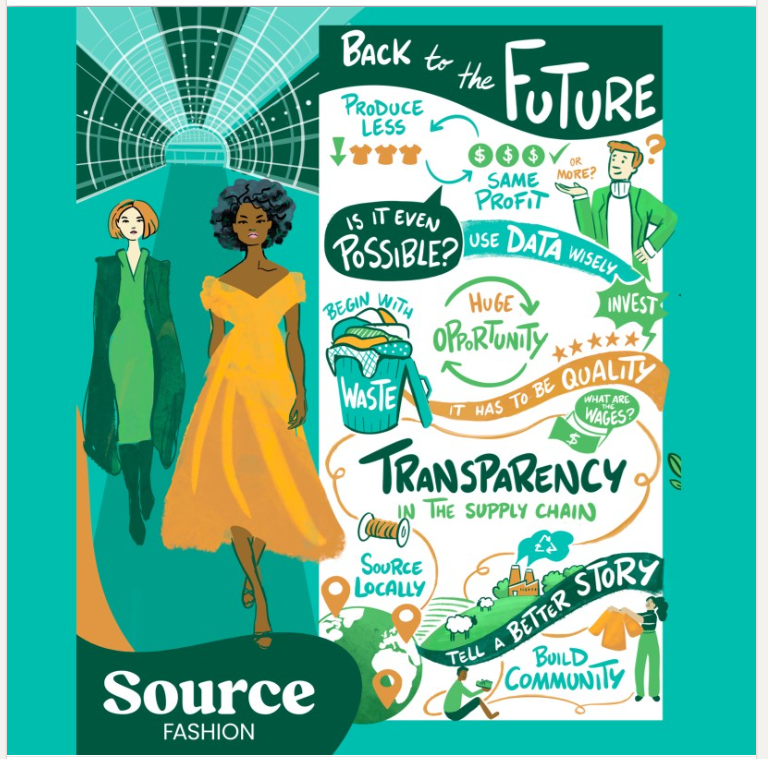Source Illustrated: Back to the Future - why producing less could be fashion’s most radical step forward
)
Welcome to Source Illustrated - a new blog series built from the energy and ideas of our Source Debates stage at Source Fashion, February 2025. We teamed up with Julia Bakay, who captured the energy and ideas into a powerful infographic. Each week we'll explore the themes from the artwork, uncovering the ideas around some of the industry's pressing question
Could fashion's future lie in its past? The now-illustrated highlights (see below) brought bold perspectives to the table and they’re just the beginning.

Is “producing less” even possible?
The debate kicked off with a provocative challenge: can brands realistically reduce output without slashing profits? Some argued that we’ve reached a tipping point. The data is clear - the planet cannot sustain our current model of production. Yet the financial question looms large: can we make the same (or more) profit by producing fewer clothes?
The discussion revealed that moving toward degrowth in fashion doesn’t mean shrinking ambition - it means redirecting it.
A future where fewer garments are made, but each item holds more value for both consumers and businesses, is entirely within reach. The industry just needs the courage to shift away from volume-driven KPIs and embrace deeper value creation.
Use data wisely. Rethink profit.
Fashion businesses have never had more tools at their disposal. Predictive analytics, AI, and customer trend data can drive smarter inventory decisions and reduce the waste associated with overproduction.
Using data wisely also means anticipating demand more precisely, reducing markdowns, and improving full-price sell-through - all of which strengthen margins while lessening environmental impact.
Data should no longer just support marketing and merchandising; it should steer the production process from concept to closet.
Quality over quantity: a strategic investment
“Produce less” isn’t a call for scarcity - it’s a call for intentionality. Everyone agreed: if we ask consumers to buy less, the quality must go up.
When brands invest in craftsmanship, responsible sourcing, and repairability, they create not just products but relationships. A well-made garment tells a story, earns loyalty, and reduces the need for constant replenishment - lowering returns, increasing customer retention, and building long-term brand equity. In theory!
Begin with waste. End with opportunity.
One of the most resonant points from the debate: waste is not just a symptom, it’s a strategy failure. Tackling waste isn’t about patching up a broken system - it’s about redesigning the system itself.
By addressing waste at the design stage - through material innovation, modular construction, or on-demand manufacturing - fashion businesses can unlock cost savings and efficiency while cutting environmental harm.
Waste reduction should be seen not as an end-of-pipe fix, but as a design principle, an operational edge, and a creative opportunity. If we design products with the 'end' in mind, how could the fashion system be changed completely?
Transparency: from buzzword to business model
Transparency was a recurring theme in the debate - and not just in supply chains. The conversations pushed for transparency in pricing, production, and purpose. That means:
-
Clear info on wages.
-
Open data on environmental impact.
-
Honest storytelling!!
When consumers, partners, and regulators understand how a brand operates, it creates shared accountability. And when that trust is earned, it becomes a powerful differentiator. Transparency doesn’t expose weakness - it signals confidence and a willingness to grow with your community. As a consumer, the reality of how an item of clothing is made often doesn't enter their purchasing decision - there's a need for the industry to try and help shift this way of buying products.
The role of community and localism
Fashion isn’t just global - it’s personal. Consumers are increasingly drawn to brands that source locally, tell a better story, and build community.
From artisan collaborations to hyper-local production hubs, brands are finding innovative ways to bring storytelling, craftsmanship, and social value closer to home. Community-led models also tend to be more agile and sustainable - with shorter supply chains, faster feedback loops, and stronger consumer loyalty.

